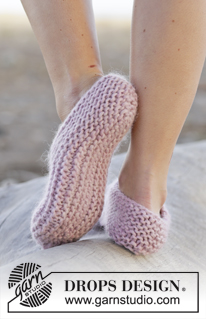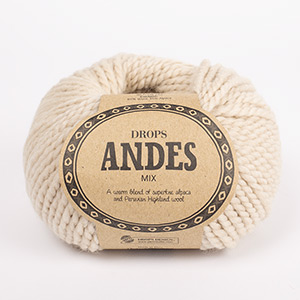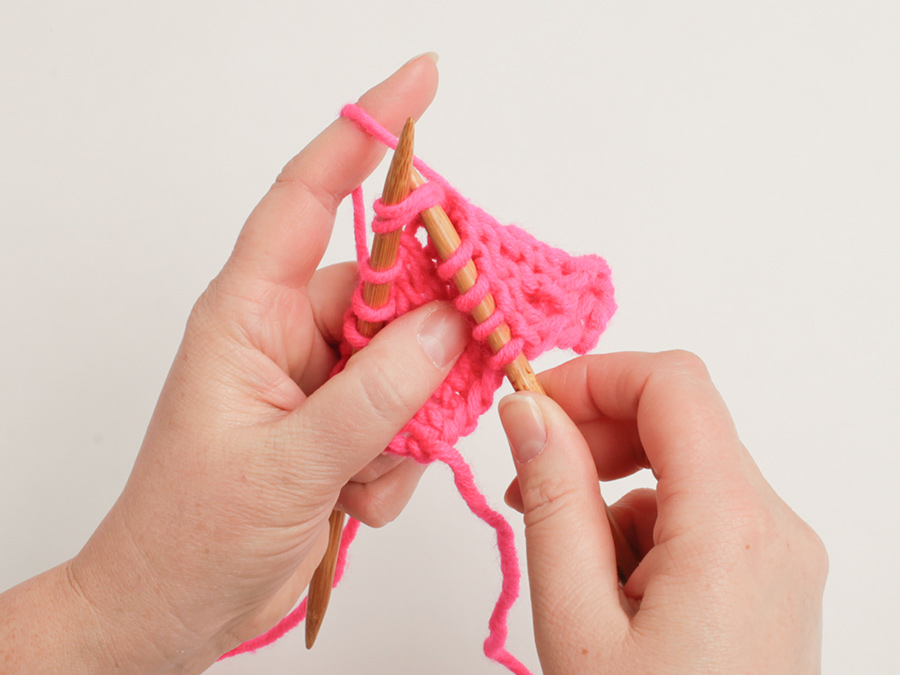Comments / Questions (8)
![]() Agnieszka wrote:
Agnieszka wrote:
Dzien dobry, co to znaczy "nabrać oczka w odległości 1 o od brzegu? I dalej: umieścić jeden marker na środku przodu i jeden marker na środku tylu" ? Gdzie są te środki?
28.09.2020 - 10:41DROPS Design answered:
Witaj Agnieszko! Jak nabierać oczka w odl. 1 o. od brzegu znajdziesz TUTAJ. Umieścić marker na środku przodu, to będzie na środku tego środkowego paska, między 2 warkoczami (środek na górze stopy, od strony palców) i drugi na środku tyłu (od strony pięty). Powodzenia!
28.09.2020 - 17:55
![]() France wrote:
France wrote:
Après avoir fait les 4cm au point mousse j'ai mis les 25m sur un arrêt et 13m sur l'aiguille je ne comprend pas vos explications, il faut faire 1m lisière au début et à la fin du rang mais pour faire le patron a-1 ça prend 15m. Est ce que je fait une augmentation au début et à la fin pou avoir 15m comme vous écrivez ?
13.05.2019 - 23:25DROPS Design answered:
Bonjour France, au 1er rang sur ces 13 mailles vous tricotez ainsi: 1 m lis au point mousse, A.1 (= 15 m) en même temps, augmentez 4 mailles (voir ici comment répartir 4 augmentations), 1 m lisière au point mousse = vous avez maintenant 17 m, tournez et tricotez le 2ème rang de A.1 sur l'envers, puis continuez A.1 comme dans le diagramme. Au dernier rang sur ces mailles, vous tricoterez 1 rang endroit en diminuant 4 m = il restera 13 m (comme avant). Bon tricot!
14.05.2019 - 08:25
![]() France wrote:
France wrote:
Bonjour après avoir mis les 25m en attente est ce que je fait les 4 augmentations en point mousse tout de suite ? Merci
13.05.2019 - 06:17DROPS Design answered:
Bonjour France, vous augmentez les 4 mailles au 1er rang tricoté sur les 11-13 mailles (= au 1er rang de A.1). Bon tricot!
13.05.2019 - 10:30
![]() Vilma wrote:
Vilma wrote:
Ohjeessa sanotaan "Kun yläosan pituus on 6½-8-9½ cm...". Lasketaanko tähän vaan kuvioneulepätkä, vai myös alun 4 cm:n suljettu neule?
18.03.2016 - 13:04DROPS Design answered:
Hei! Tässä tarkoitetaan ainoastaan kuvioneuleen mittaa.
23.03.2016 - 16:25
![]() Lene wrote:
Lene wrote:
Disse var kjempesøte og veldig lettstrikkede! Anbefales.
16.11.2015 - 14:43
![]() Baconnet wrote:
Baconnet wrote:
Bonjour, une fois fait les 4 cm il faut tricoter les 11 premières mailles et mettre les autres sur un arrêt ou alors diviser le travail, 11-25 et couper le fil au bout ? Merci de votre aide
25.03.2015 - 14:09DROPS Design answered:
Bonjour Mme Baconnet, après les 4 cm point mousse, ne coupez pas le fil, mettez les 25-27 dernières m du tour en attente et continuez sur les 11-13 premières m du tour et tricotez en allers et retours les torsades comme indiqué. Bon tricot!
25.03.2015 - 16:02
![]() Giuliana wrote:
Giuliana wrote:
Veloci da fare e caldi!
10.01.2015 - 14:31
![]() José Serné wrote:
José Serné wrote:
Snel klaar met maximaal resultaat. Daar zou ik zo 10 paar van breien in verschillende kleuren.
14.12.2014 - 21:19
Cozy Spring |
|||||||||||||
 |
 |
||||||||||||
Knitted DROPS slippers in garter st with cables in "Andes". Size 35 - 42
DROPS 160-22 |
|||||||||||||
|
GARTER ST (worked in the round): * K 1 round and P 1 round *, repeat from *-*. 1 ridge = 2 rounds. GARTER ST (back and forth): K all rows. 1 ridge = 2 rows K. PATTERN: See diagrams A.1 and A.2. The diagrams show all rows in pattern seen from RS. ---------------------------------------------------------- LEFT SLIPPER: Knit in the round to the instep, then continue back and forth over the upper foot and then in the round again over the whole slipper, to the underside of the foot. The slipper is sewn together at the underside of the foot at the end. Cast on 36-38-40 sts on double pointed needles size 6 mm with Andes. Work in GARTER ST in the round - see explanation above - until piece measures approx. 4 cm, finish after 1 round P. Now keep the first 11-13-13 sts on the round and slip the remaining 25-25-27 sts on 1 stitch holder. Work back and forth as follows: 1 edge st in GARTER ST – see explanation above, A.1 (= 13-15-15 sts), 1 edge st in garter st – AT THE SAME TIME on 1st row inc 4 sts evenly = 15-17-17 sts. When middle part measures 6½-8-9½ cm - adjust so that next row is worked from RS, K 1 row and dec 4 sts evenly = 11-13-13 sts. Now work in the round as follows: Pick up 12-14-16 sts from middle part inside 1 edge st, work the 25-25-27 sts from stitch holder, pick up 12-14-16 sts from middle part inside 1 edge st = 60-66-72 sts. NOW MEASURE PIECE FROM HERE! Insert 1 marker mid front of toe and 1 marker mid back on heel. Continue in garter st. REMEMBER THE KNITTING TENSION When piece measures 2 cm, K 2 tog on each side of every marker every other round (= 4 sts dec every other round). Continue dec until piece measures 5-5-6 cm, cast off. RIGHT SLIPPER: Work right slipper the same way but work middle part according to A.2 instead of A.1. ASSEMBLY: Sew seams under foot in outer loops of edge sts to avoid a chunky seam. |
|||||||||||||
Diagram explanations |
|||||||||||||
|
|||||||||||||

|
|||||||||||||
|
Have you made this or any other of our designs? Tag your pictures in social media with #dropsdesign so we can see them! Do you need help with this pattern?You'll find 19 tutorial videos, a Comments/Questions area and more by visiting the pattern on garnstudio.com. © 1982-2025 DROPS Design A/S. We reserve all rights. This document, including all its sub-sections, has copyrights. Read more about what you can do with our patterns at the bottom of each pattern on our site. Have you finished this pattern? |
|||||||||||||






























































Post a comment to pattern DROPS 160-22
We would love to hear what you have to say about this pattern!
If you want to leave a question, please make sure you select the correct category in the form below, to speed up the answering process. Required fields are marked *.